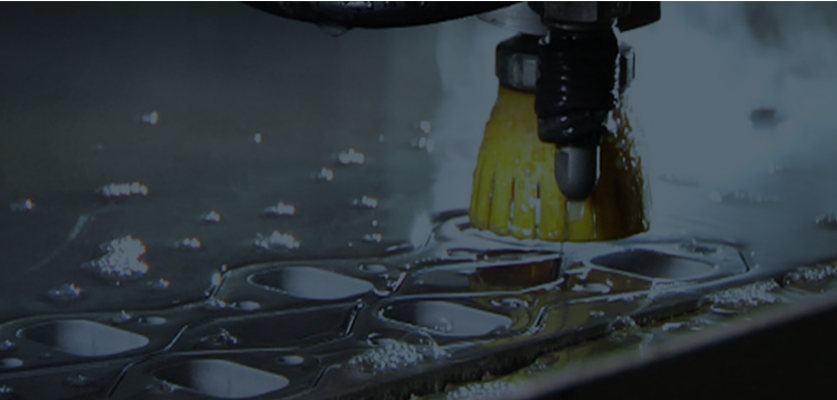Does the abrasive waterjet method make sense for 2-axis metal cutoff?
Modern waterjet cutting has its roots in using water (although at comparatively low pressure) to cut soft materials such as paper and food, going back to the 1930s. Thanks to the evolution of high-pressure technology and equipment, today’s abrasive method is capable of precision metal cutting.
But does waterjet cutting make sense for 2-axis cutoff of small metal parts? Evaluating the advantages and disadvantages of the process is critical to deciding whether the method will meet your needs.
Some Advantages of Abrasive Waterjet Cutting
A water jet for cutting metal utilizing high-pressure water and a granular abrasive — primarily, garnet powder. In this way, waterjet cutting is typically used to make complex shapes in the X/Y axes of large, flat sheets of metal or composite material.
The addition of the abrasive at the nozzle boosts the cutting ability of the high-PSI water stream. It also allows the machine to be used with water-only for positioning (or the “rapid”) and then with an abrasive for cutting the workpiece.
Abrasive waterjet cutting does not generate heat. That means it can be used to cut various metals, as well as plastics and other materials, without melting, distorting, or warping. The method is capable of tolerances as close as ± 0.005″ (0.127 mm) if needed.
Depending on the end use of the cut parts, waterjet cutting of metal can also provide different cut edge qualities. These differences are achieved by varying the speed of the process; a faster speed can be used when the goal is separation of material without regard to the cut edge. However, where parts need to have a close tolerance and smoother edge finish, a slower cutting speed is required. So, the edge quality has an impact on the cost of the job, with a better quality edge taking longer to produce.
Some Downsides to Waterjet Cutting
As with a laser beam, the waterjet cutting stream is most effective when it is most concentrated. But when cutting through tubing, voids can cause the stream to diffuse, rapidly losing its accuracy and cutting ability.
Similarly, stranded or fibrous materials will act like honeycombs and can also “squirm” in the stream, resulting in a poor cut. In addition, when cutting fibrous material, some of the waterjet stream “slides around” around the material to be cut instead of going through it and making a clean cut. This can cause a defective end cut that is often called the nib.
To ensure optimal cutting with waterjet cutting, the right standoff height — the distance between the waterjet nozzle exit and the workpiece — is 1 mm (0.0394”) to 1.5 mm (0.0591”). This is impractical with 3D parts that simply don’t allow such proximity.
A more common consequence is that for precision dimensions, the waterjet kerf always has a taper shape. That taper can wreak havoc on precision tolerances, with conical and barrel effects. While a modern waterjet cutting machine compensates for those effects by “tilting” the nozzle, the cut surface can show a bending pattern that causes a slope in the cut.
Abrasive Powder Issues
Abrasive waterjet metal cutting requires the metal that is being cut to be softer than the abrasive powder that is being fed into the nozzle as part of the waterjet stream. So, for example, while it is possible to cut tungsten with waterjet machining using garnet powder, it is very challenging because tungsten and garnet are so close in hardness on the Mohs scale.
With waterjet abrasive garnet blasting away at a rate of 60,000 PSI or more, the garnet powder can rough up or matte the finish of any surrounding, exposed material. This hazing might be strictly cosmetic — or it may be functional if it affects the surface finish and the material’s Ra value.
The average waterjet cutting setting can produce 2 pounds of wasted abrasive garnet power for every minute of cutting. Of course, the amount of waste depends on the thickness of the cut, the material, and other factors. But as a rule, something that takes 15 minutes to cut produce 30 pounds of abrasive garnet debris, mixed in with a lot of water. This becomes a major disposal issue.
In addition, only about 5% of the garnet powder used actually performs the cutting action; the balance is just part of the waterjet stream path. Studies have found that after ejection, some of the garnet is fractured. That makes it problematic to recycle the garnet powder for reuse; although not dull, the fractured media won’t deliver the proper cutting action.
To Waterjet or Not to Waterjet?
As with other precision metal cutting methods, abrasive waterjet cutting has trade-offs — issues that need to be balanced against the benefits. However, other methods may be a better choice for applications such as 2-axis cutoff of small precision tubes, rods, and wires.
Making the decision requires an in-depth understanding of your unique application and its specific parameters, as well as an understanding of the other options.
How does waterjet cutting compare with other precision metal cutting methods? Keep reading to find out.






